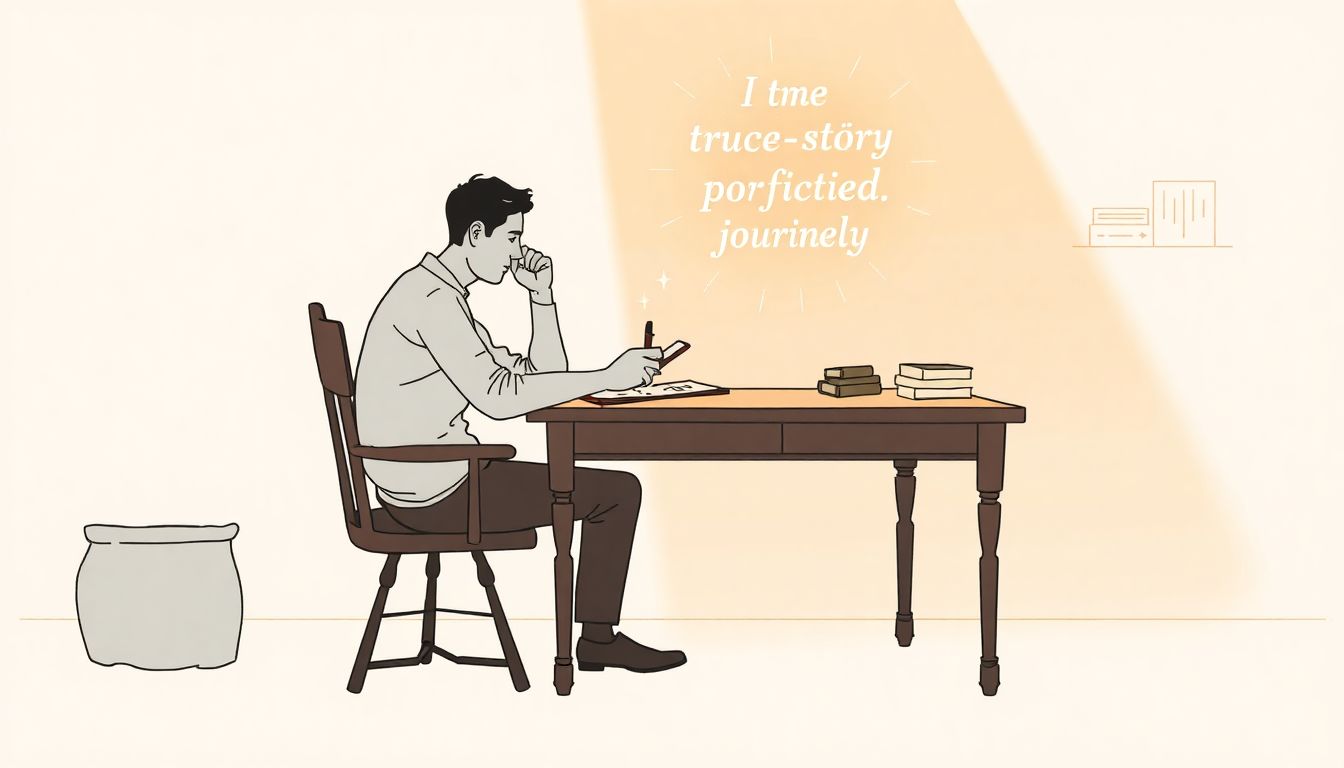Creative nonfiction can sometimes feel tricky, right? You’ve got a true story itching at your fingertips, but crafting it in an interesting, organized, and authentic way isn’t always easy.
That’s exactly what we’re going to tackle together. By following a few simple steps, you’ll learn how to grab readers from the first sentence, keep them glued with powerful writing techniques and structure, and share your story in a genuine way.
Ready to make your true story shine? Let’s jump right into the first step.
Key Takeaways
- Start your creative nonfiction with a genuine, specific story to instantly capture reading interest.
- Use dialogue, pacing, descriptive language, and storytelling methods from fiction writing to create engaging and readable nonfiction.
- Structure and organize your stories clearly—either chronologically or by theme—to maintain reader interest and understanding.
- Always fact-check and provide accurate information from reputable sources to maintain credibility.
- Create vivid scenes by appealing to senses (sight, sound, touch, smell) to immerse readers deeper into your narrative.
- Select the right perspective (first, second, or third person) based on the story you’re sharing.
- Include honest personal reflections and emotions to build authentic connections with readers.
- Share relatable lessons and insights subtly throughout your story to encourage reader reflection.
- Read high-quality creative nonfiction regularly, keep a consistent journaling practice, and participate in supportive writing groups for constructive feedback.

Step 1: Start with a True and Compelling Story
If you’re aiming to draw readers into your creative nonfiction writing right from the start, nothing beats beginning with an authentic, captivating story. Readers are naturally drawn to real-life experiences because they create immediate emotional connections, making them feel invested from the first paragraph.
When crafting your opening story, keep it focused and genuine—avoid generalities and exaggeration. One helpful trick is to zoom in on a specific moment that illustrates a broader theme you want to explore. For example, if you are writing about overcoming challenges in self-publishing your book, you could start with an anecdote about stressing over formatting your manuscript for Amazon KDP before discovering helpful advice on how to publish your book to Smashwords or overcoming your struggle figuring out how to get a book published without an agent.
Keep your opening paragraphs brief, punchy, and vivid. Detail makes a story feel real and immersive. Even a small, relatable struggle—like spending hours deciding between the best fonts for book covers—can resonate with readers as it humanizes your writing style.
Step 2: Use Literary Elements to Improve Your Writing
Creative nonfiction doesn’t mean boring essays or textbooks—it means using fiction-writing elements to keep your prose lively and engaging. Think of it this way: you’re telling a true story, but you’re dressing it up with all the storytelling tools normally reserved for novels or short stories.
One important literary element is dialogue. Dialogue moves stories along quickly, keeps readers engaged, and helps show distinct personalities. Remember to format your dialogue correctly for clarity and readability.
Don’t forget pacing, either. Some scenes demand slow, lingering sentences to build tension or emotion, while others call for quick, punchy statements to boost drama and action. Mix sentence lengths and structures for rhythm and readability, but always write as if you’re having a casual conversation with a close friend.
Additionally, metaphors, similes, and descriptive language can greatly boost your storytelling powers. Just don’t overdo it—you want your descriptive elements to be vivid yet authentic and natural. Readers appreciate when your literary creativity feels effortless and honest instead of forced or overly fancy.
Step 3: Organize Your Creative Nonfiction Clearly
No one enjoys reading a rambling story with confusing timelines or irrelevant details. Solid organization is key to writing compelling creative nonfiction that keeps your reader’s interest and effectively communicates your ideas.
Consider structuring your piece chronologically if you’re describing an event or following a specific narrative. This will help readers follow along without feeling lost. Alternatively, thematic organization might work better if your piece explores broader ideas or events spanning across different times and places.
Break your writing down into shorter, manageable chunks—using brief paragraphs and sections clearly labeled with subtitles or headings can help lead readers comfortably through your work, especially on mobile devices.Organizing carefully also assists you in pinpointing where certain stories or reflections naturally fit, making your writing process smoother and reducing writer’s block. If you’re feeling stuck, consider using creative prompts such as fall writing prompts or inspiration from other nonfiction books and articles, boosting your creativity and structure simultaneously.

Step 4: Research and Provide Accurate Information
Yes, creative nonfiction is all about telling true, engaging stories—but accuracy is everything, my friend.
You earn your readers’ trust by double-checking your facts and figures thoroughly.
Never assume your memories alone are flawless, because even the sharpest minds stumble.
Dive into credible sources, like industry reports or reputable sites, to enrich your narrative with concrete data.
For instance, if you’re writing about trends in the nonfiction market, you’ll find that nonfiction book sales are expected to jump from $15.3 billion in 2024 to $15.78 billion in 2025—a clear sign that readers still crave real-world stories.
Avoid opening yourself up to challenges by linking to trusted resources when stating stats or studies—your credibility depends on it.
Step 5: Write Scenes That Keep Readers Interested
The truth is, creative nonfiction isn’t just about dry facts—it’s about capturing people’s attention through vivid, engaging scenes.
One great trick to writing captivating scenes is to appeal to the five senses.
Describe not just what happened, but how things felt, sounded, or even smelled at the time—you’d be surprised how immersive this makes your writing.
Another helpful tip is pacing: shorter sentences, quick dialogue, or abrupt scene shifts can inject energy and urgency into your storytelling.
Include a mix of action, setting details, and dialogue, but keep everything relevant—each scene should push your narrative forward or reveal something important about a character or idea.
If you’re short on scene ideas, prompts like these winter writing prompts can get your creativity flowing again.
Step 6: Choose the Right Point of View for Your Story
The short answer: The best point of view depends entirely on the specific story you’re sharing.
For pieces closely tied to your personal experiences and reflections, first-person storytelling works like a charm because it creates immediate intimacy and authenticity.
However, sometimes third-person limited is useful too, allowing readers to glimpse events through the eyes and experiences of different people involved—perfect for more complex storytelling or histories.
Second-person narrative isn’t as common, but it is effective if you want readers to feel like they’re part of the scene or experience; think of it like giving readers an interactive tour of your memories or situation.
Pay attention to your chosen point of view, though, and make sure you stay consistent to avoid confusing readers.
If you’re unsure which viewpoint suits your work, experimenting with each is a helpful exercise—write the same short scene in different perspectives to see what resonates most naturally.
Step 7: Add Your Personal Feelings and Reflections
People read creative nonfiction because they want to hear authentic human voices and experiences—not robotic recitations of events alone.
Share your internal reactions clearly—your hopes, disappointments, confusion, or growth—and keep it genuine.
Using empathetic vocabulary helps here; admitting you felt overwhelmed or motivated at certain moments makes readers relate closely to you.
Here’s a useful tip: while reflecting, don’t over-explain; give just enough emotion or reflection, and let readers interpret and relate those insights to their own experiences.
Use concrete examples of when you changed your views or learned a valuable lesson, tying directly back to the experiences or challenges your readers might face too.
Step 8: Share Meaningful Lessons and Insights
The beauty of creative nonfiction writing lies partly in the valuable lessons readers take away.
Think about what you learned through the experiences you’re writing about—maybe a surprising insight, a changed attitude, or an impactful life lesson.
These insights are often deeply personal and don’t have to be grand; smaller realizations resonate uniquely well.
You’re not preaching here, just gently guiding readers toward meaningful conclusions or ideas they can reflect on.
Another important trick: Include subtle hints about the lessons throughout your narrative, giving readers gratifying moments where things click into place.
Step 9: Improve Your Writing by Reading Other Creative Nonfiction Books
Like any skill, writing improves significantly when you regularly consume quality examples of the genre you care about.
Dive into award-winning creative nonfiction, highly ranked literary magazines, or popular memoirs to see how seasoned authors develop engaging prose and storytelling techniques.
Places like Clifford Garstang’s ranking for nonfiction literary magazines can point you toward excellent publications worth studying closely.
Observe closely how established authors structure memoirs, use pacing and dialogue, or seamlessly blend facts and personal reflections.
Don’t copy style outright; instead, pay attention to what you personally enjoy and what resonates strongly with you—and try integrating similar elements naturally into your own writing.
Step 10: Keep a Journal to Practice Regularly
If you’re serious about writing better creative nonfiction, there’s no better practice than keeping a daily (or at least consistent) journal.
Journaling helps you sharpen your observational skills, reflect deeply on personal events, and practice articulating your feelings clearly and succinctly.
When journaling, explore different writing exercises, such as descriptive practice, dialogue snippets, character sketches, or personal reflections.
You’ll end up growing your own writing style organically over time, so when you do work on a specific creative nonfiction project, your voice already feels polished, comfortable, and authentic.
Consistency is key, even if you write just a few lines a day—it quickly stacks up into a valuable writing habit.
Step 11: Find a Writing Community or Group for Feedback
Writing creative nonfiction can sometimes feel lonely, but finding a supportive community makes a big difference.
Joining writing groups or informal feedback circles puts you in contact with others who understand what you’re trying to do; they’ll see strengths and weaknesses you might overlook yourself.
Don’t worry—feedback shouldn’t feel intimidating; ideally, it’s about mutual support and friendly constructive criticism.
Plus, joining groups opens doors to motivating activities like writing contests and anthology submissions; for example, in March 2025 alone, there were dozens of free writing contests for nonfiction, giving ample opportunity to practice your craft and have fun while doing it.
Find general writing groups, or even context-specific communities around particular topics or themes relevant to your work.
In the long run, real and supportive relationships will benefit your creative nonfiction growth substantially more than going solo—after all, writing shouldn’t be a solitary sport.
FAQs
Start by choosing a powerful, true-life moment or event that instantly engages readers, provokes curiosity, or creates an emotional connection. Introduce characters and conflict right away, using sensory details to make the story vivid and memorable.
You can add literary elements like dialogue, imagery, and metaphor by carefully describing real-world details and conversations. Each element should naturally align with your narrative, highlighting themes and creating authentic emotional responses from your reader.
Selecting the right point of view impacts the reader’s connection to your narrative and shapes their perspective. First-person creates intimacy, while third-person expands narrative possibilities. Consider your desired tone and reader experience to decide your approach.
Including your feelings, discoveries, and reflections allows readers a deeper understanding of how events shaped you. Authentic personal insights deliver emotional resonance and reveal meaningful lessons, building a stronger connection with your audience.
